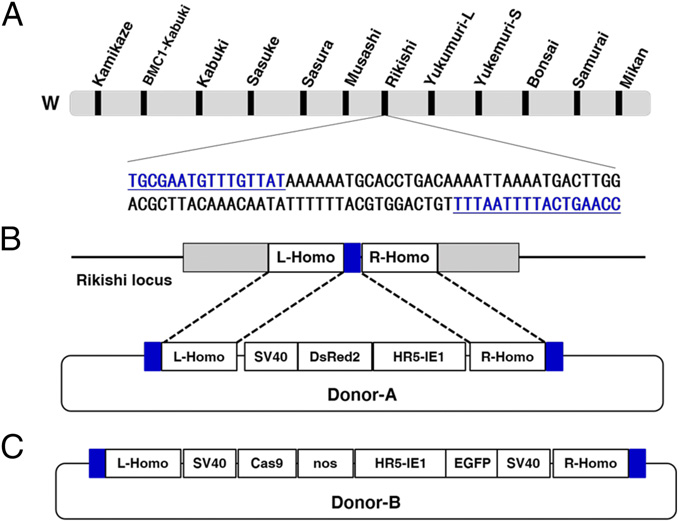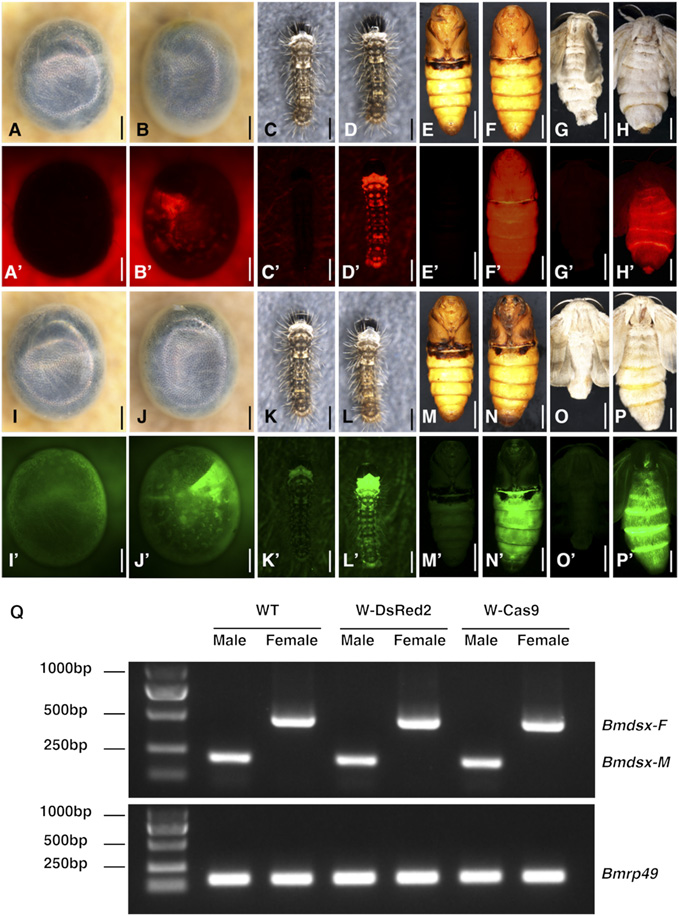Silkworm genetic sexing through W chromosome-linked, targeted gene integration
Male silkworm produces better filament than conspecific female strains. Therefore, it has been a long term goal for silkworm breeders to culture male-only silkworm strains. Traditionally, insect sex sexing are based mainly on morphological characters, classic genetic approaches or alternative splicing difference of genes between the female and male individuals. However, these methods need improvement to overcome the labor cost, strain fitness and the alternative splicing leak.
The chromosome composition of typical lepidopteran insects are ZW type. Heterogametic ZW is female, whereas homogametic ZZ is male. Here, we describe targeted gene integration of fluorescent marker expression cassettes into a randomly amplified polymorphic DNA (RAPD) marker region in the W chromosome of the lepidopteran model insect Bombyx mori using transcriptional activator-like effector nuclease (TALEN)–mediated genome editing. This silkworm strain shows ubiquitous female-specific red or green fluorescence from the embryonic to adult stages. Furthermore, we developed a binary, female-specific, embryonic lethality system combining the TALEN and the clustered regularly interspaced short palindromic repeats (CRISPR)/CRISPR-associated protein 9 (Cas9) technology. This system includes one strain with TALEN-mediated, W-specific Cas9 expression driven by the silkworm germ cell-specific nanos (nos) promoter and another strain with U6-derived single-guide RNA (sgRNA) expression targeting transformer 2 (tra2), an essential gene for silkworm embryonic development. Filial 1 (F1) hybrids exhibit complete female-specific lethality during the embryonic stage.
The lepidopteran insects include economically important silkworm and over 70% of agriculture and forestry pests. The exact sex control to this group of insects is not only important for economic production, but also for the environmentally friendly pest control. The sexual regulation combines with newly developed gene drive system will be one of the future alternatives of the sterile insect techniques. Our study provides a promising approach in sex control for silkworm and lepidopteran pests with WZ/ZZ sex chromosome systems.
This work, entitled “Silkworm genetic sexing through W chromosome-linked, targeted gene integration”, has been published online in Proceddings of National Academy of Sciences of American on August 13, 2018.
Design of integration on W chromosome

Genotype and phenotype of gene insertion

Successful approach for the sexual regulation

Article link:
https://doi.org/10.1073/pnas.1810945115
Contact:
Dr. Yongping Huang, Professor
CAS Key Laboratory of Insect Developmental and Evolutionary Biology
CAS Center for Excellence in Molecular Plant Sciences/Shanghai Institute of Plant Physiology and Ecology (SIPPE)
Chinese Academic of Sciences
Tel: 86-21-54924047
Email: yphuang@sibs.ac.cn